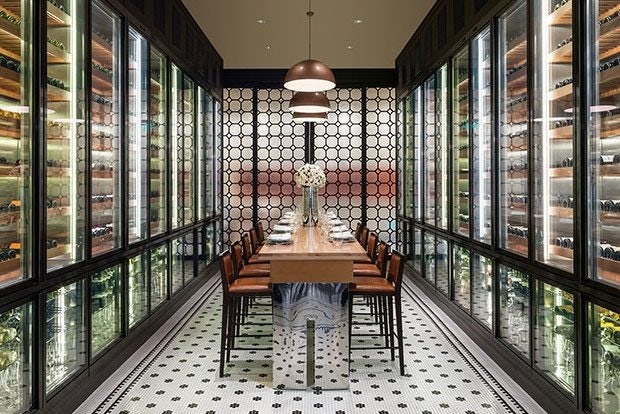
A private tasting room at St. Regis Chengdu's wine bar, Decanter. (Courtesy Photo)
As the top country for red wine consumption in the world, China now has a growing base of wealthy oenophiles eager to broaden their knowledge and develop their personal taste. As Chinese drinkers branch out beyond established appellations from "Old World" locales such as Bordeaux and Burgundy, preferences are becoming distinct as a growing number of “New World” wines are paired with China’s diverse regional cuisines.
At the front line of this trend in China’s booming southwestern city of Chengdu is St. Regis Chengdu’s new head sommelier Tong Zhu. Trained at Le Cordon Bleu in France, Zhu curates the wine list for the Chengdu’s only dedicated wine bar located in the hotel, as well as St. Regis Chengdu's multiple dining options including its Sichuan/Cantonese restaurant Yan Ting. Zhu previously served as the chief sommelier at chef Christophe Dufossé’s Jinyue French Restaurant in Chengdu and has worked at Michelin-star restaurant Drourant in Paris.
Zhu recently talked to Jing Daily about how Chinese drinkers’ wine preferences differ across regions, what it takes to curate a quality wine list in China, and which wines pair best with Chengdu’s spicy Sichuan cuisine.
What are some trends you are observing among Chengdu’s wine drinkers?#
With a wide variety of wine tasting events as well as Chengdu’s annual wine tasting party held in March, Chengdu’s wine enthusiasts have a growing number of opportunities to enjoy different varieties of wine from around the world.
This has also spurred the development of the wine market in the southwest, and wine is increasingly becoming everyone’s favorite. Enthusiasts feel that wine has a certain charm and are helping to spread the culture of wine. A growing number of special courses and training institutions have sprung up in Chengdu to help consumers choose wine and better understand their individual preferences. The St. Regis Chengdu tasting pavilion bar also from time to time provides different classes and wine-themed gourmet dinners.
What do Chinese wine drinkers like to drink these days? Has there been a shift in preference? If so, what caused it?#
Due to pop culture’s constant influx into the country, a growing number of Chinese students studying abroad, and Chinese people who live abroad and return to the mainland, more new food and beverage elements have been introduced.
A dining table during earlier times only had baijiu and domestic beer and wine, but now features cocktails, whiskey, Cognac, and different red and white wines from all over the world.
As people obtain more information, they are choosing wines that fit their individual preferences. This is why St. Regis Chengdu has Chengdu’s only dedicated wine bar curated by a sommelier. Since guests come from different backgrounds and have different preferences, it offers customized beverage selections.

St. Regis Chengdu Head Sommelier Tong Zhu. (Courtesy Photo)
What is the most popular wine at St. Regis Chengdu?#
As head sommelier at St. Regis Chengdu, I always want to make our restaurant and bar guests make better selections. In the first four months since opening, most of the guests have preferred wines that offer excellent value for money and are easy to drink from our wine of the world (WOW) list. For wine lovers, Starwood offers a selection of high-quality wines from wine-producing areas worldwide.
When I was making the wine list, I tried to create pairings for Yan Ting’s Sichuan and Cantonese cuisine, as well as Western food served at our other dining locations. I selected more New World red and white wines such as Australia, New Zealand, and Argentina, as well as China.
Are there regional differences in wine consumption and preference?#
Yes, because each region has its own food and drink customs. Sichuan cuisine is very spicy and affects people’s flavor preferences. Spices can dramatically alter meat or vegetables’ original flavor, so when one drinks wine with Sichuanese food, they will generally choose a heavier bodied, fruity, spicy, rich red wine, such as Australia- and New World-produced Syrah and Cabernet Sauvignon.
Meanwhile, Shanghai, for example, prefers relatively light seafood dishes and flavors. If one is drinking wine that is too strong, it will destroy the original flavor of the fish and other seafood. Therefore, a more simple and elegant white wine or red wine such as Pinot Noir would be more suitable for Shanghai people's preferences.
What makes a wine appealing to local consumers?#
I think first of all it is a product’s openness; many local consumers are unfamiliar with wine, which causes fear and anxiety about buying fake wine. Inexpensive prices, however, have caused many to be enticed to buy poor-quality wine, and consumers don’t know where they can find places where they have peace of mind about what they’re buying.
Secondly is the price: a 50 to 300-RMB (US$8 to $48) bottle is most easily acceptable to consumers, so the prices of 16 bottles of red and white wine on the St. Regis WOW list are kept between 100 and 400 RMB, in addition to the option to buy by the glass.
Finally, I think it was the wine itself has properties that help sleep and promote healthy blood circulation, which has captivated a vast number of consumers. It’s also important to remind consumers to drink in moderation and avoid drinking and driving.
This interview was translated from Chinese.